Apple's new iPad 3 – review - author (Charles Arthur)
In answer to your first question: yes, there is a difference. In answer to your second: yes, you can actually see the difference. It's subtle, and yet it's definitely there.I'm talking, of course, of the "Retina Display" on the new iPad (which is what Apple seems to be calling it – no marketing niceties such as "iPad 3" or "iPad HD"). With much fanfare, Tim Cook unveiled it last week and the world said "wow!" or "is that all?", depending on the viewer's disposition. Expectations had been cranked high (about touch displays – ahem), but after so many had wrongly forecast the coming of the retina display last year (overplaying Moore's Law), expectations were about right this time. But the incremental updates that Apple is making – having established this sector – don't satisfy those who would like more, all at once.

The new iPad with its high definition screen. Photograph: Robert Galbraith/Reuters
I'm talking, of course, of the "Retina Display" on the new iPad (which is what Apple seems to be calling it – no marketing niceties such as "iPad 3" or "iPad HD"). With much fanfare, Tim Cook unveiled it last week and the world said "wow!" or "is that all?", depending on the viewer's disposition. Expectations had been cranked high (about touch displays – ahem), but after so many had wrongly forecast the coming of the retina display last year (overplaying Moore's Law), expectations were about right this time. But the incremental updates that Apple is making – having established this sector – don't satisfy those who would like more, all at once.
So the key question is whether the new iPad is "wow!" or "huh".
The screen is the computer
The essential thing about a tablet – particularly a "slate" like the iPad – is that the screen is pretty much all there is. Sure, there's all the stuff around the back, such as the processor, the graphics processor, the storage, the battery and the wireless connectivity. But on its own, the screen is what you deal with. So if that's better, you should benefit.So, in specifications, the iPad 2 has 1024x768 pixels on a 4:3 9.7in screen, giving it 132 dots per inch (DPI). The new iPad has 2048x1536, giving it four times as many pixels (3.1m, Apple points out; more than the typical HD TV set) and a resolution of 264dpi, which when held at a distance of about 40cm (15in) means that the average eye can't discern adjacent pixels. With the old iPad, you could … perhaps. Actually, even last year at least one expert was suggesting that the iPad 2 was "almost identical" to the iPhone 4's retina display.
In fact, the difference between the visible screen quality of the iPad 2 (still available, but at a reduced price) and the "new iPad" isn't immediately obvious. I tried putting the two side by side and looking at the icons: even for Apple's icons, which you would expect would have been optimised for the new super-ultra-hi-res screen, it was hard to tell that anything had changed. (I also enlisted an 11-year-old just to make sure it wasn't my eyes at fault. He didn't spot the difference immediately either.)
But there is a difference. The clearest example comes from looking at two covers from the Newsstand app, where the difference between the covers of the Economist and New Yorker was clearly visible: on the iPad 2 the covers were pixellated, while on the new iPad they were sharper.
Here's the iPad 2:
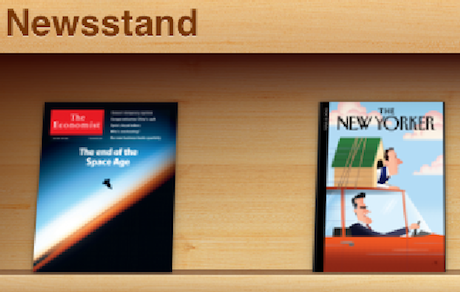 Newsstand on the iPad 2: note pixellation
And now the iPad 3:
Newsstand on the iPad 2: note pixellation
And now the iPad 3: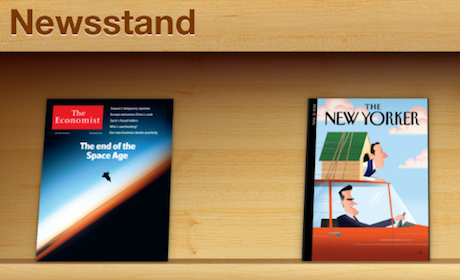 Newsstand on the iPad 3: note less pixellation
The screenshot shows the difference when you magnify it to the pixel level, first on the iPad 2:
Newsstand on the iPad 3: note less pixellation
The screenshot shows the difference when you magnify it to the pixel level, first on the iPad 2: Detail of Newsstand cover on iPad 2
And now the iPad 3:
Detail of Newsstand cover on iPad 2
And now the iPad 3: 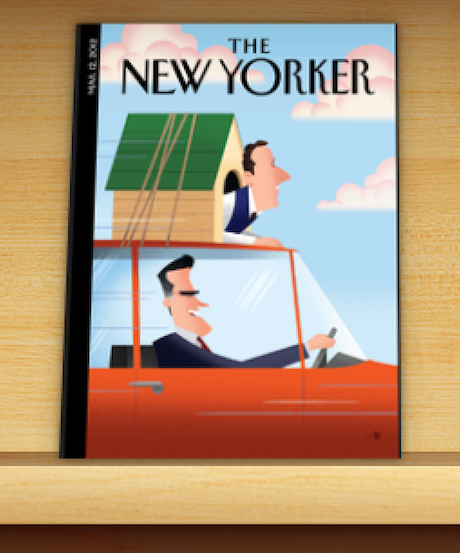 Detail of Newsstand cover on iPad 3
That difference is small, but it's real. And while it's close enough
to be almost subliminal, the extra tidiness of the letters – possibly
better than you can get with physical print – and icons gives this
experience a tidiness, a cleanliness that you rarely experience on
electronic devices.
Detail of Newsstand cover on iPad 3
That difference is small, but it's real. And while it's close enough
to be almost subliminal, the extra tidiness of the letters – possibly
better than you can get with physical print – and icons gives this
experience a tidiness, a cleanliness that you rarely experience on
electronic devices.It also exists at system-level facilities such as the keyboard, which gains extra sharpness – and the letters on the keys really do get an extra helping of precision. Again, it's not a dramatically obvious difference (and most computer screens can't show the difference natively), but when you bring up the keyboards on the two devices side-by-side there is a faint furriness to the iPad 2 that isn't there on the new one.
This is the iPad 3 keyboard detail:
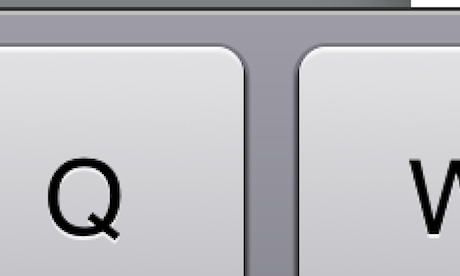 Detail: Q and W on iPad 3 keyboard
Notice how the anti-aliasing works around the circle of the Q; this is one of the hardest shapes to do well.
Detail: Q and W on iPad 3 keyboard
Notice how the anti-aliasing works around the circle of the Q; this is one of the hardest shapes to do well.And now the iPad 2:
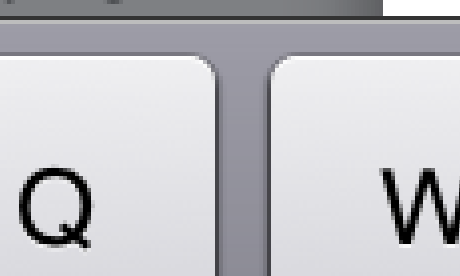 Detail: Q and W on iPad 2 keyboard
And finally for comparison, because I had it to hand, the BlackBerry
PlayBook (which is a 7in, 1024 x 600 pixel screen, with a resolution of
169 dpi) running the PlayBook 2.0 software. The PlayBook used to be
ahead of the iPad 2 in dpi (169 v 132):
Detail: Q and W on iPad 2 keyboard
And finally for comparison, because I had it to hand, the BlackBerry
PlayBook (which is a 7in, 1024 x 600 pixel screen, with a resolution of
169 dpi) running the PlayBook 2.0 software. The PlayBook used to be
ahead of the iPad 2 in dpi (169 v 132):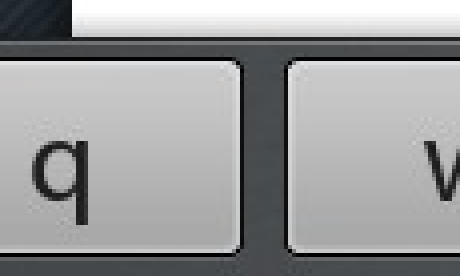 Detail: BlackBerry Playbook keyboard detail
You can see that the keyboard's Q isn't as clean in the anti-aliasing.
Detail: BlackBerry Playbook keyboard detail
You can see that the keyboard's Q isn't as clean in the anti-aliasing.Update: @lollygagging points out in the comments that the PlayBook by default seems to use about 60% compression on screenshots, so that picture above will include some artefacts from the lossy JPEG compression. The question of the Playbook screen remains moot - though its given DPI is lower than the iPad 3 (but still ahead of the iPad 2).
So the screen is better: more detailed, especially down at the system level. Now the question is: does that difference make a enough of a difference for it to be worth your money to either upgrade or buy?
Part of the problem in answering that is that although the retina display on the iPad has been expected for ages, there don't seem to be developers around who have taken advantage of it. That in turn means that it's only Apple's apps which have been updated to take advantage of the new high-definition display. So apps like Newsstand do show it – when it comes to covers. But on comparing the same article from the New Yorker under high magnification (a screenshot that is then enlarged), there's actually no difference, because the articles are
Update: corrected: those aren't PDFs, which would scale perfectly, but images, which don't scale.
That is going to cause some problems for magazine publishers who ship their products as
But for experiences such as games and other apps, the level of detail is going to offer developers thrilling chances. Apple showed off some games that are under development for the new iPad, which take full advantage of the pixel detail on offer; if you need to get the feeling that there really are rivers of molten lava flowing under the bridge on which you're standing, that's the place to see it.
The downside? Those apps are going to get bigger. It's hard at present to foresee quite how much of a problem that's going to be: will app writers shift over to scalable vectors (it would be wise)? Will people just resort to Wi-Fi? I don't know, but with forecasts that apps could grow in size fivefold to accommodate that detailed screen.
Of course other content will benefit too – particularly high-definition content. I watched the first episode of the BBC's series Orbit, which is available in standard definition (boo) or high definition (yay!), which is a 1.7GB download (gulp).
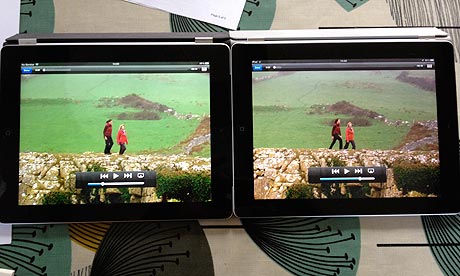 Left is the iPad 3; right the iPad 2 – both showing a scene from the
BBC programme Orbit (the HD version) with the screens of both on full
brightness
And again, you can see the difference. The detail seems minor, but if
the camera has captured it then the iPad 3 will show it. I compared
Orbit on an iPad 3, iPad 2 and new 1080p Apple TV on an HD TV. (The nice
thing being I only had to buy it once.) On the iPad 2, some of the fine
detail was lost on an early shot around clifftops. On the HD TV, the
colours were richer, I thought; but on the iPad 3, as much as anything
because you're closer, you can pick out detail that simply isn't visible
across a room on a TV.
Left is the iPad 3; right the iPad 2 – both showing a scene from the
BBC programme Orbit (the HD version) with the screens of both on full
brightness
And again, you can see the difference. The detail seems minor, but if
the camera has captured it then the iPad 3 will show it. I compared
Orbit on an iPad 3, iPad 2 and new 1080p Apple TV on an HD TV. (The nice
thing being I only had to buy it once.) On the iPad 2, some of the fine
detail was lost on an early shot around clifftops. On the HD TV, the
colours were richer, I thought; but on the iPad 3, as much as anything
because you're closer, you can pick out detail that simply isn't visible
across a room on a TV.So what we might call That Screen definitely does make a difference. Expect that other companies will try to match it (there's no point exceeding it) in short order; by the end of the year it's likely that only Apple (with the iPad 2) and the low-end Android tablets will be offering non-retina displays. (And Apple will probably be making the better profit out of it.) In fact, as Benedict Evans of Enders Analysis put it recently in a tweet you can read as ironic or factual, "a baby born today will never see a pixel".
The rest of the iPad experience is much the same. Apple says that the screen now has enhanced colour reproduction; that's quite hard to discern, though again the comparison of the iPad 3 against the iPad 2 (in the picture, the newer is on the left) with both turned to maximum brightness shows that yes, the bright is brighter and the dark seems just as dark – so a greater brightness range.
Cameras
The back camera gets an upgrade, to 5 megapixels, and the same assembly as the iPhone 4S. There's also HD video, which gets video stabilisation (through the processor; so only the new iPad gets it). What's the use, you ask, in having 5MP and HD video on a tablet? You don't take photos or video with them.But actually I suspect that, given this facility, people will start shooting video with iPads – especially now that Apple has iMovie for the iPad which offers all sorts of built-in functions. For taking a film, quickly cutting it together and uploading it, this could be – well, not ideal, but a lot better than trying to do it on a camera, and simpler than filming it and transferring it to a computer to cut it there (even if you'll do it better). Expect to see plenty more iPads reflected in mirrors and so on in YouTube, and the words "this is my first video, and …".
And even if you don't have any use at all for a camera, even a 5MP one, or HD filming – you're effectively getting it for nothing.
Voice dictation
Siri hasn't come to the new iPad; instead, there's what you might call "Siri lite". That is, whenever the keyboard pops up, you also get the option of hitting the microphone button and dictating instead. Hands-free input! What could be better?I have to say that it's not great. To be honest, it's not even good. With Siri, there's the advantage that you tend to speak in short bursts, which makes the speech-to-text part of the process easier. With dictation, especially for long notes, you tend to talk in longer sentence-ish clauses, which the back end is much less good at handling. I tried it over a 3G connection, using a mic built into a pair of Skullcandy headphones. Here's what I said, and what it offered back:
I said: "The new iPad has voice dictation which should mean that you can speak to input text directly."
It offered: New iPad has voice dictation shipmen speak text input directory (It was 8am, so I wasn't slurring – or not more than usual.)
I said: "However, in my tests I found that it wasn't very accurate."
It offered: However in my tests I've found that it wasn't very accurate. (OK.)
I said: "You have to use short sentences and speak very clearly."
It offered: You have to use short sentences speak very clearly. (Note that it missed "and".)
I said: "But even then it will miss occasional words such as 'the'."
It offered: Even though it warmness occasional searches. (Huh?)
I tried it on Wi-Fi, in a quieter environment. The results weren't much better. Short sentences it's good with – so "yeah that's great I'll see you later" came out perfectly three times in a row. But "I don't think you've ever seen one of those ever before" came out as "I don't did you see monomers and before". Conclusion: don't throw away the touch keypad. (Well, you can't.) Or the spare keyboard, if you have one. This barely counts as a feature at present until it gets much, much better. (Dragon Dictation is a free app and does much the same job using the same back-end technology.)
Update: some people have asked me whether the Voice Dictation just isn't attuned to British accents. The answer: I don't know. Siri does OK, generally, with my voice.
Processor
Although Apple says that this device is using an A5X processor – which sounds like the iPhone 4S to the iPhone 4, compared to last year's A5 processor – benchmarks suggest that there's no difference in the standard compute power (though the RAM is up to 1GB - that's half what you get on the lowest-spec MacBook Air; all the improvement is in the graphics processor. Those pixels won't shift themselves, you know.Storage
Nothing's changed here: it still comes in 16GB, 32GB and 64GB flavours. So much for the rumours about 128GB. The point to realise about Apple's strategy is that it's increasingly about the cloud: giving you devices on which you can store loads of content makes you less likely to put it on multiple devices. Also, if you buy something like a TV episode, then you can play it on any number of iPads, iPhones, Apple TVs and Apple Macs if they're all using the same account. This is actually pretty neat – and makes the storage point moot. Bill Gates said in 2005 that Blu-ray DVD would be the last physical format. He was right.Battery
The new iPad has a 42.5 watt-hour capacity, compared to 25Wh for the iPad 2 (so 70% more). Some new technology? Apple wouldn't say, though clearly the fact that the device is barely any thicker suggests it has done something radical. But it's still claiming the same 10-hour life between charges, and my side-by-side tests suggest that this is true: even if you were to turn off the connectivity, you wouldn't magically get 17 hours' capacity. What seems likely is that those extra pixels, while smaller, are using up more energy overall; somewhere in the mix between four times more pixels in the same screen space, and 70% more power, you get equality. (If each new pixel uses 42% as much energy as each old one, then that would make sense.)For all this, the new iPad barely weighs any more. That's remarkable.


